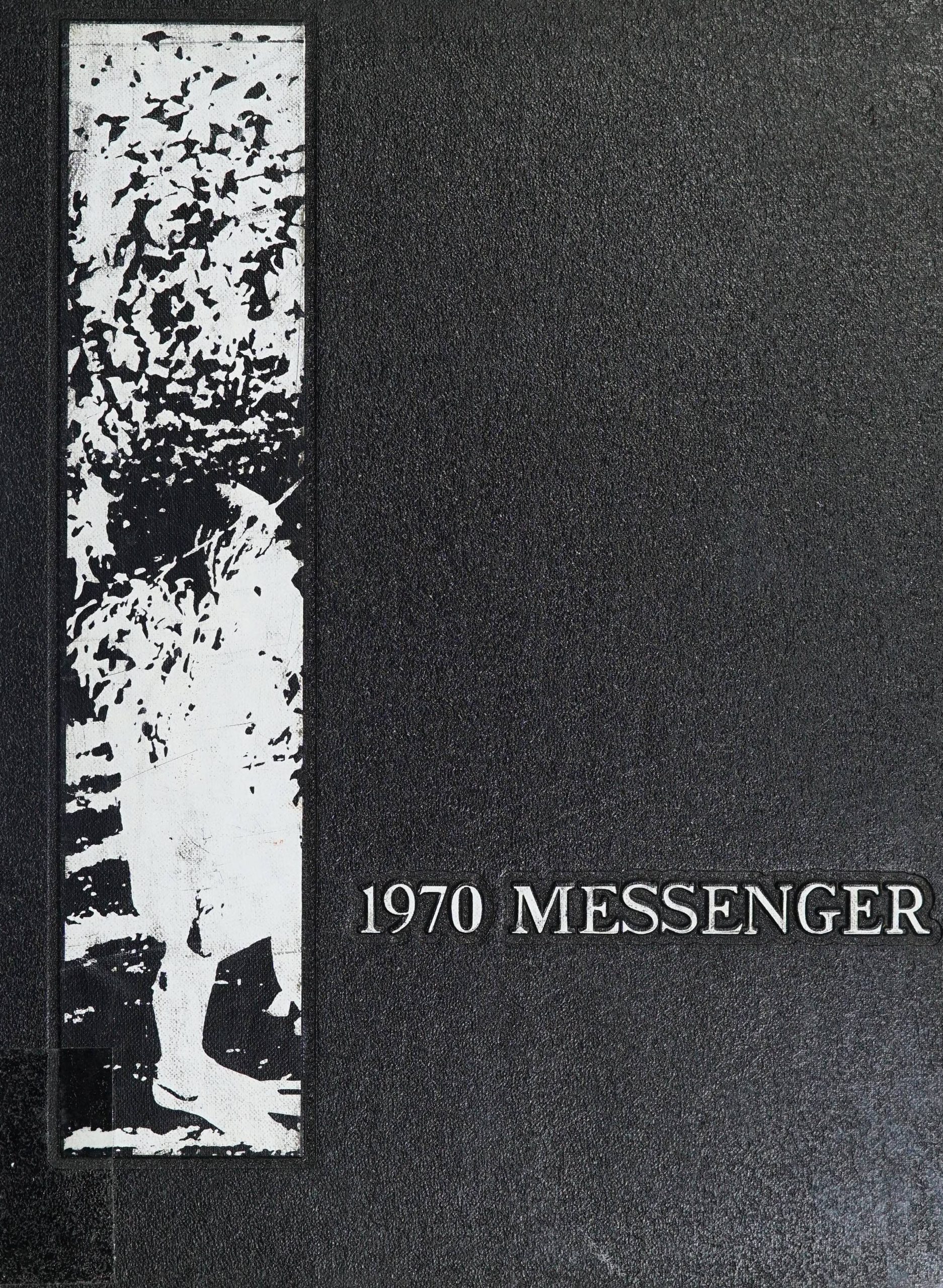
To learn more about the Durham County Library, please visit their website. For more yearbooks from across North Carolina, visit our yearbook collection.
Viewing search results for "Durham County Library"
View All Posts
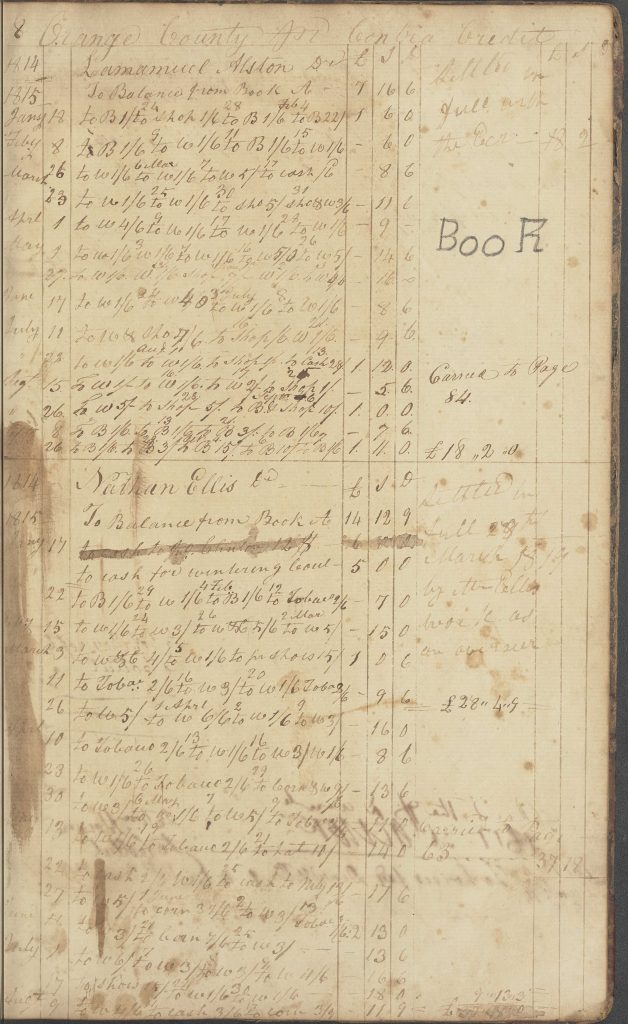
The North Carolina Digital Heritage Center has made available some exciting materials dating back to 1812 with help from our partners at the Durham County Library!
The Latta Family Account Ledger [1812-1821] details the accounts of residents in and around Orange County at the time and includes many well known early Durham families such as the Lattas, Rigsbees, Mangums, Holloways, and Leighs.
Minutes from the School Committee of District No. 27 in Durham County from 1897 were found in between the pages of the ledger. A special item is a handwritten letter from an unidentified person writing to their sister about their time at Fish Dam School. There are also several Allen-Owen Company Receipts [1910] found alongside the ledger and a handwritten sermon.
This batch of materials is openly available for research and covers a range of topics. Genealogists looking for family histories can benefit as well as folks interested in education, entrepreneurism or religion. To learn more about the area please visit the Durham County Library website.
As residents of Durham, nature fans and music listeners may already know, the annual Festival for the Eno is quickly approaching. And while the Eno River Association has several past and present posters available, our latest batch of materials from our partner, the Durham County Library, includes some of the older vintages.
This poster, from the 1982 festival, features an alert river otter, a species found across the state of North Carolina. While sightings of otters are usually rare (they tend to be secretive and their total population is somewhat low), they are playful animals.
In the 1990s, according to the North Carolina Wildlife Resources Commission, there was an effort to re-expand the territory of river otters into the western part of the state, where they were seen in the 1930s. To do this, the NC Wildlife Resource Commission trapped and relocated several to western river systems. They also brought several otters to West Virginia, which was trying to restore its otter population.
In exchange for otters, the West Virginia gave North Carolina wild turkeys, which brings us to the 1985 poster: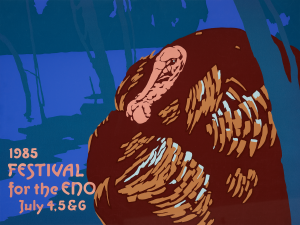
The wild turkey is also a native North Carolinian, but the population declined quickly in the early 1900s due to overhunting and habitat loss. In 1985 (during restoration efforts), the total population was estimated at 14,000; in 2020, it was estimated that our state was home to 270,000 turkeys. Today, turkeys are classified as “Big Game,” and their hunting season is strictly limited.
Other posters from the earlier years of the Festival for the Eno feature fish, people in costumes, and other landscapes. Some of the informational posters have lists of performers and activities as well.
You can see the full batch of maps and posters from the Durham County Library here. To find out more about them, you can visit their partner page or their website. The 43rd Annual Festival for the Eno will be held on July 2 and 4, 2022 in Durham, N.C.
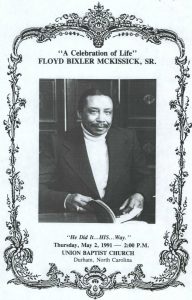 More funeral programs and obituaries that are part of the R. Kelly Bryant Obituary Collection are now on DigitalNC. This collection is housed in the the Durham County Library North Carolina Collection. R. Kelly Bryant (1917-2015) was a historian with an extensive knowledge of Durham, North Carolina who collected the stories of thousands of African American residents told through funeral programs and obituaries. The collection is organized alphabetically by surnames, and this batch includes the names Keith through McLean, which means collectively the names Adams through McLean are now available on DigitalNC.
More funeral programs and obituaries that are part of the R. Kelly Bryant Obituary Collection are now on DigitalNC. This collection is housed in the the Durham County Library North Carolina Collection. R. Kelly Bryant (1917-2015) was a historian with an extensive knowledge of Durham, North Carolina who collected the stories of thousands of African American residents told through funeral programs and obituaries. The collection is organized alphabetically by surnames, and this batch includes the names Keith through McLean, which means collectively the names Adams through McLean are now available on DigitalNC.
Included in this batch is the funeral program for Jean Hopkins Lucas (1935-2007), the first African American woman to serve in North Carolina’s state Senate. Also included are the funeral programs for civil rights activists Floyd McKissick (1922-1991) and Evelyn Williams McKissick (1923-2004). There are countless amazing stories and tributes captured in this collection, making it a great source for research.
To learn more about R. Kelly Bryant and his archival collection at Durham County Library, visit their finding aid. To see all of the digitally available programs and obituaries, visit the R. Kelly Bryant Obituary Collection exhibit page.
Also please take a look at other materials from the Durham County Library that are up on DigitalNC by visiting their partner page.
A new set of maps, posters, and architectural plans from our partner, the Durham County Library, has been added to our site. They range in time from the late 1880s to the present, and many provide local insight to the culture of Durham.
One of the most exciting maps that we’ve added is this mid-century Western States Publishing Co. Map—perhaps one of the last versions that documents Durham before I-85 (1958) and N.C. 147 highway were built (1967-1970). Comparing it to the city today, you can tell what was disrupted during construction.
Similarly, this map of Durham from 1920 notes the schools in the area and whether they served Black or White students. According to this map, many of the schools closest to the city center only served White students, while many of the Black schools are further out in the county.
Another neat item in this batch is this Historic Durham County Poster created by John B. Tomlinson. Around the drawn map of Durham County are illustrations of some of Durham’s famous and historic landmarks, including Duke University’s West Campus, NC Central University, and the County Courthouse. These and other annotations help identify some of the big moments in Durham’s history, such as the surrender of J.E. Johnston at Bennett Place.
Another item that illuminates a part of Durham’s history is this set of architectural plans for the house of Mrs. L.L. Morehead. The house was built for Eugene Morehead, son of former North Carolina Governor John Motley Morehead, and Eugene’s wife, Lucy Lathrop Morehead. The house was torn down in 1961, but photos and illustrations of the final product are still around. Other building plans for the house, including some of the interior, were also uploaded in this batch.
In terms of more modern materials, take a look at these two bike maps: one from 1991, and one from 2010. The entire back side of the 1991 version is covered in safety information, like how to wear a helmet and 10 tips for “frustrating” a bike thief (No.8 is to “Engrave your social security number on expensive parts,” which doesn’t seem like common advice today.). Meanwhile, the back of the 2010 map is more like a typical city map, with directories of things in downtown Durham.
One bonus of these maps is that they are catalogued and finable through the Durham Public Library’s website. You can see all the maps we digitized in this batch here, and you can see all materials from Durham County Library here. For more information about the library and their holdings, visit their website.
Thanks to our partner, Durham County Library, several new maps and plans for areas and buildings in Durham County are now available on our website.
The materials in this batch include renovation and addition plans for the George W. Watts Elementary School, a combined public hearing map for a state project on Alston Avenue in Durham, Eno Park plans, and plans for Lake Michie recreation facilities. These plans and maps are a wonderful resource for individuals who are interested in the growth and change of Durham County since the 1960s.
Designed by the landscape architects and land planners from Coulter Associates in Durham, North Carolina, the Eno Park Phase II master plan is particularly wonderful to look at thanks to its bright colors and neatly labeled areas.
To view more materials from Durham County Library, please click here.
To learn more about the Durham County Library, please visit their website.
Thanks to our partner, Durham County Library, the 1966 to 1970 issues of the Durham High School yearbook are now available on our website. This set of yearbooks spans when Durham High was integrated and offers some hints at how the students viewed the change.

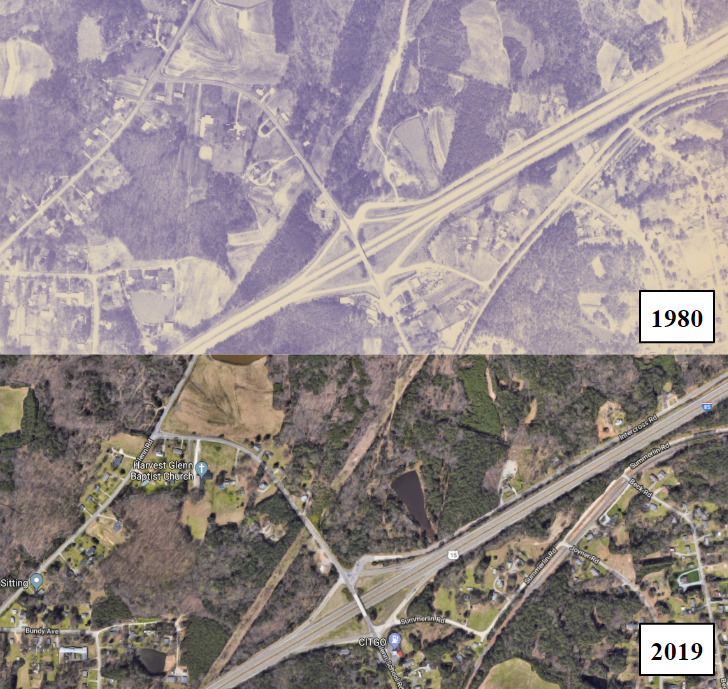
Comparison of part of I-85 from 1980 and 2019
Thanks to the Durham County Library, DigitalNC now hosts several aerial photographs and maps of the county from the second half of the twentieth century. Among the 1980 aerial photographs is a 1951 zoning map, which focuses mainly on the borders of the county and shows all major roads, bodies of water, and railroads. Landmark Engineering Company from Cary, NC, took the aerial photographs on March 13, 1980. They document the landscape of much of Durham County, though some are annotated to include street names.
Each photograph is identified by a four digit number followed by a two digit number in the bottom right-hand corner of the page. This index shows all four digit zones and how they split into four sections with two digits each. Use landmarks such as roads to identify the location of the photograph or map, then these locations can be matched to current landmarks on Google Maps or a similar tool. The hand drawn sketch (left) shows which segment of the county each grouping of photographs documents.
To view all maps and photographs in this batch, click here. To learn more about the Durham County Library, visit their contributor page here or their website here.
Seven scrapbooks documenting Durham’s United Fund campaigns of the 1960s are now available on DigitalNC thanks to our partner, the Durham County Library. These scrapbooks supplement seven others from the 1950s which share the origins of the campaign. The scrapbooks are mostly comprised of clippings from local newspapers, with most dates transcribed on the clipping itself.
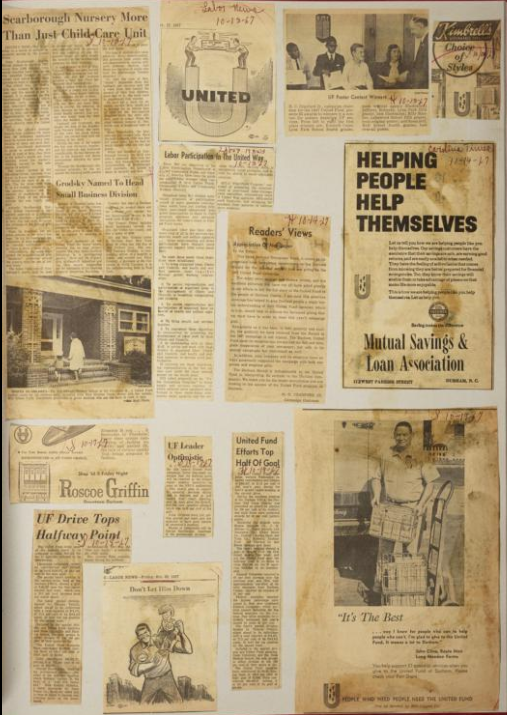
A page from the United Fund scrapbook, 1966-1967
The United Fund campaign began in 1953 as a collaboration of over 30 Durham community organizations to better facilitate their fundraising needs. The newspaper clippings in these scrapbooks document the Fund’s progress to help Durham communities by sharing organization news, advertisements, and even some event programs.
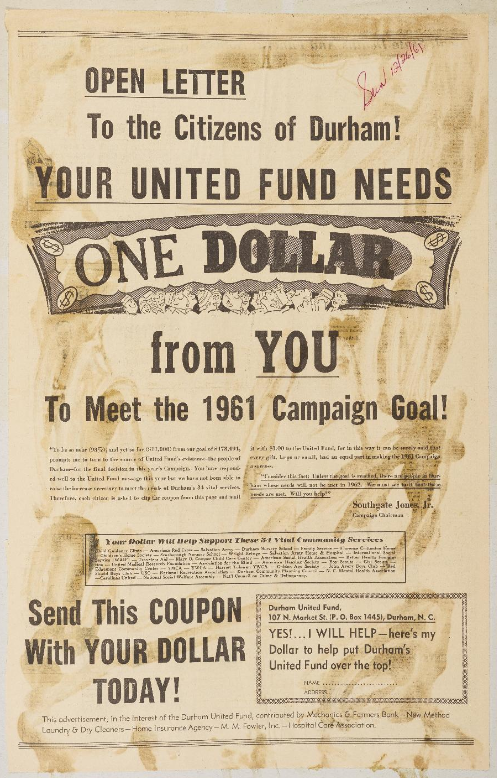
“Open Letter to the Citizens of Durham,” United Fund scrapbook, 1961
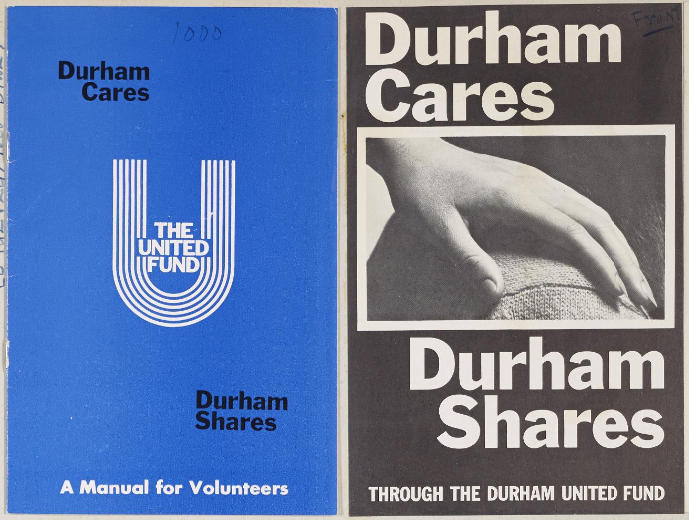
“Durham Cares, Durham Shares” pamphlets, United Fund scrapbook, 1968
To see all United Fund scrapbooks, click here. To learn more about the Durham County Library, visit their partner page here or their website here.
In the early days of the North Carolina Digital Heritage Center, we digitized thousands of records created during the Durham Urban Renewal Project. Recently, we revisited these records with the intention of making them more accessible and useful to our partners and the public.
The Durham Redevelopment Commission was established in 1958 with the intention eliminating “urban blight” and improving the city’s infrastructure as more and more personal vehicles filled the city’s streets. Durham Urban Renewal targeted seven areas — one in Durham’s downtown district and six in historically Black neighborhoods including Hayti and Cleveland-Holloway. The projects in these six neighborhoods impacted approximately 9,100, or 11.7%, of Durham citizens at the beginning of the project in 1961. Although the initial timetable for the project was ten years, the project efforts went on for nearly 15 years and was ultimately never completed. By the end of the urban renewal efforts, more than 4,000 households and 500 businesses were razed and a new highway — NC 147 — stretched through the heart of Durham.
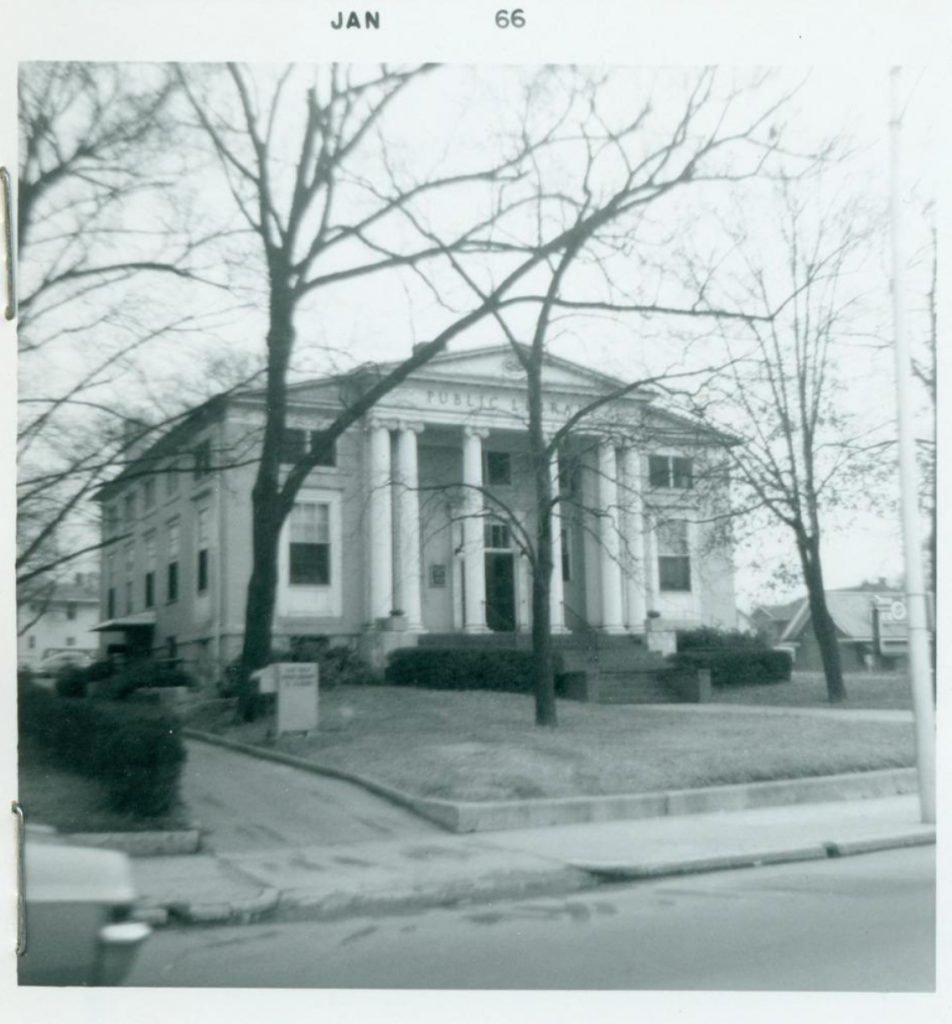
Some structures included in the collection, such as the second home for the main branch of the Durham Public Library, outlived the urban renewal project and still stand today. This building is located at 311 East Main Street.
The Durham Urban Renewal Collection contains studies, reports, appraisals, property records, photographs, brochures, and clippings that span the nearly 20 years of urban renewal projects. These materials are artifacts of Durham before, during, and after urban renewal dramatically altered the city.
In an effort to make these materials as accessible and accurate as possible, we recently completed a major cleanup of the collection. Properties are now listed by complete street address. Many of the residential properties — and some commercial properties — were appraised more than once during the urban renewal process. We have consolidated all appraisals, photographs, and other records for individual properties into single listings, and text in these records are full-text searchable. We also used historical maps of the city from the years of urban renewal to provide additional information for unaddressed or mislabeled appraisals and records. In addition to the changes made to improve accessibility by address, we made efforts to ensure that the names of property owners are complete, accurate, and consistent across the collection, so that records may be located more easily in searching by the owners’ names.
The materials in the Durham Urban Renewal Collection came from Durham County Library’s North Carolina Collection and are only a portion of the materials contributed by the library to date. To learn more about the Durham County Library, visit their website or partner page.
A batch of scrapbooks documenting Durham’s United Fund Campaign are now online at DigitalNC courtesy of our partner Durham County Library. These scrapbooks hold newspaper clippings and advertisements for the United Fund for the years 1953 and 1955 to 1960. Efforts to develop a United Fund for Durham officially began in 1953, so these scrapbooks document the early days of the fund and its subsequent growth.
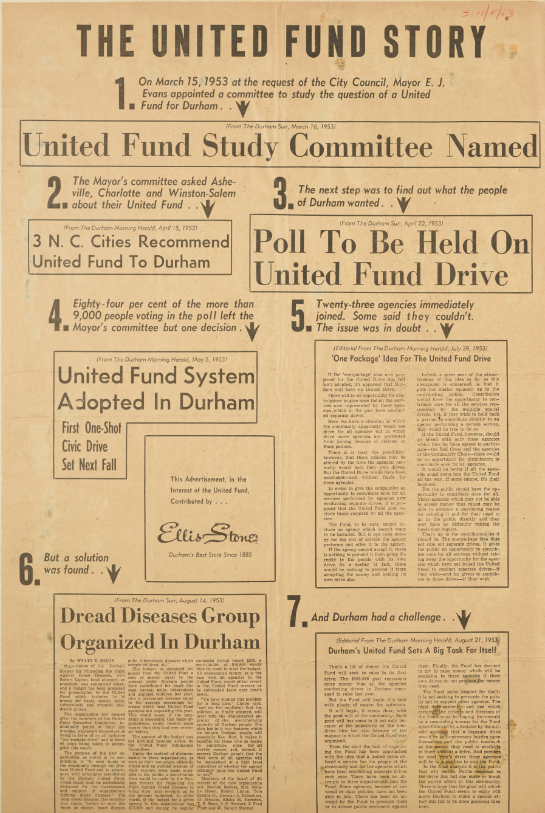
The United Fund Story from the 1953 United Fund Scrapbook.
The United Fund joined the campaigning efforts of more than 30 Durham community organizations in an effort to lessen the fundraising burden of each and increase the funds raised for all. The scrapbooks detail the ways in which many local businesses and citizens donated to the United Fund. Monies collected went to support organizations like the Girl Scouts, the Red Cross, and to fight diseases such as polio, cancer, tuberculosis, and heart disease.
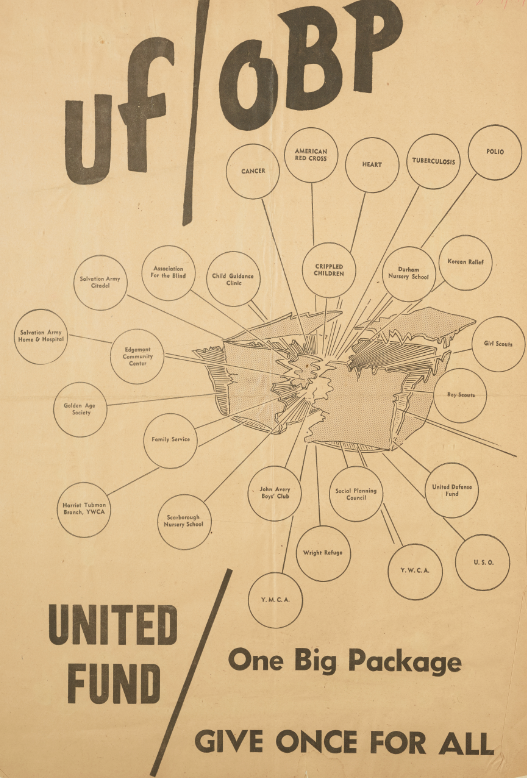
An advertisement from a local newspaper encouraged citizens to “Give Once For All” for Durham’s United Fund and detailed many of the organizations included.
Some of the clippings promise that displaying evidence of earlier contribution “provides the basis for immunity from further solicitation” by any of the organizations included in the United Fund.

This clipping promises “immunity from further solicitation” once donations were made to The United Fund.
Others communicate the fund’s urgency in some interesting ways … like by asking if participants will need “victory whistles or crying towels” at the next meeting.
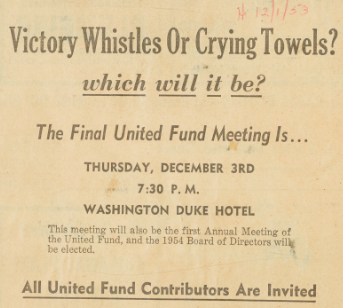
United Fund contributors were invited to the first annual meeting.
These scrapbooks detail times of considerable change in Durham, and join an already substantial collection from Durham County Library. To access more from Durham County Library, visit their partner page or their website.

This blog is maintained by the staff of the North Carolina Digital Heritage Center and features the latest news and highlights from the collections at DigitalNC, an online library of primary sources from organizations across North Carolina.